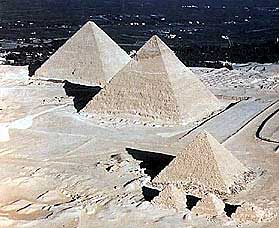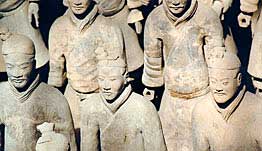Agrarian State (2)
Secondary Traits of Agrarian States
In addition to the major traits, a variety of other characteristics are associated with intensive agriculture.
- Urbanization. Intensive agriculture saw the development of large, dense concentrations of non-food producers, called cities. (Hence the origin of the word civilization.)
- Monumental public works. As signs of both the power of the state, and the class differences intrinsic in this mode of production, most early states built large permanent "public" works using the conscripted labor. This included the dams, irrigation and drainage systems necessary for intensive agriculture. Also included are temples, palaces, roads, public granaries, and burial places for the ruling elite. Archaeologically, various monumental public works are the most recognizable trait of early states.
 
Pyramids at Giza, Egypt and a few of 6,000 Life-sized Qin Dynasty Terra Cotta Warriors
- Writing. Concurrent with the development of the bureaucracy of a state system, all intensive agricultural societies developed a form of written language. It is not that horticulturalists lack the intelligence to develop writing, but they had no need of writing.
- Specialists in knowledge (science). Among the other full-time occupational specialists present were specialists in knowledge, particularly in mathematics, astronomy, and in writing itself. Horticulturalists, pastoralists, and foragers knew enormous amounts about their environment, much of it being lost with the disappearance of these modes of production. In non-state societies however, most of the considerable available knowledge was shared with almost everyone else. Non-state societies were fairly egalitarian in the distribution of knowledge, as well as everything else. In early states however, knowledge was the prerogative of a relative few, and knowledge became a privilege of the upper class. At the same time, since there were specialists in fields of knowledge, the amount of information available to the entire culture began to grow dramatically.
- Hierarchical, bureaucratic religious organizations. With full-time religious specialists, normally operating in support of the political state, priests dominated religion belief systems. There was an emphasis on the religious approach and on moral behavior, and religion in agrarian states typically became hierarchical and bureaucratic.
Exchange Systems
States have reciprocal exchange, as well as stratified redistributive exchange (taxes). However, market exchange, particularly price market exchange, becomes increasingly important. Horticultural and pastoral societies often had at least some market exchange, but price markets quickly became the norm for agrarian states (as well as of course for industrial states). Price market exchange has the following characteristics.
- The price of goods and services exchanged is determined by buyers competing with other buyers, and sellers competing with other sellers. This was not usually the case in horticultural markets. It might well be that I, as a horticultural farmer, might take my excess pigs to a market to exchange my pigs for some good pottery made by a part-time specialist. The potter wanted pork, I wanted some pots, and the exchange was made. We both felt the exchange was of equal value, and the value did not fluctuate. However, as market exchange became increasingly important for both food producers and non-food producers, how many pots I could get for my pigs might depend upon how many people were selling pigs, and and how many people were buying pots. If many people were selling pigs, I might have to pay many pigs for my pot, particularly if everyone wanted pots. If I was the only pig seller, and nobody wanted to buy pots, I could buy several pots with one small pig. This is a price market.
- Price markets leads to anonymous exchange: the buyer and seller do not need to know each other. Once the exchange is made, no further obligation or contact is necessary between buyer and seller.
- Within a price market, everything ultimately comes to have a price or value, measured against some standard. While theoretically anything--pigs, for example--could be used as the standard of value, in practice all states eventually turned to a somewhat contrived standard, money. Money must be
- Portable (Pigs have a problem here as a standard of value.)
- Divisible (Pigs have a big problem here. If I divide my pig, I obviously must kill it, which presumably alters its value.)
- Convertible, meaning higher and lower units are good. (Another big problem with pigs. Are two halves of a pig as good as a whole pig? And what about the fact that if I took half of a big pig it is presumably more valuable than the half of a little pig? Are each of the four quarters of a pig of equal value?)
- General, meaning all goods and services have a price in terms of money.
- Anonymous, meaning that anyone with the price can buy.
- Legal, meaning that money must have the backing of the political state in order to have a value.
Price or money markets came to be a significant trait of all agrarian states; money markets should be easy for anyone in US culture to understand, as we and all other modern states are dependent upon market exchange.
Mode of Reproduction
Many of the characteristics discussed earlier under mode of reproduction for horticultural and pastoral societies continue. Factors affecting reproductive rate and death rate include the following:
- Intensive agriculture increased the value of having more children. The mode of production did indeed produce more calories per unit area (acre or square mile) of land. From the point of view of the majority of the peasants, the more children the better. Children could do productive economic work at a very young age. Families usually had to pay taxes in grain, and also might have to provide labor for the state. The larger the family, the higher its standard of living (after taxes)!
- Population sizes became larger and denser, particularly in urban areas. The peasants particularly suffered from a poor diet. As a result of both these factors, contagious diseases became an increasing problem.
- The relative prestige of females compared to males remained low. As a result, the unequal treatment of women and girls continued, and resulted in a shorter life expectancy among women. The large numbers of pregnancies contributed to the high death rate in women. Female infanticide became more common.
Expansion and "Progress"
The intensive agricultural mode of production proved to be the most expansive yet. As population size increased, the peasants particularly found their standard of living threatened. Expansion was the easiest way for a state to settle its problems. Expansion against horticultural or pastoral tribes particularly was easy for the larger, more organized political states. Tribal people were incorporated into the political state, and their culture was lost, though sometimes after significant resistance. When states invaded chiefdoms, the chiefdom often reacted by becoming a state itself, and perhaps engaging in prolonged warfare with the invaders. Regardless of who won, the agrarian state as a mode of production triumphed.
The early Shang dynasty in China expanded against groups like the traditional Hmong. Did the Hmong consider it progress? Obviously not, since they resisted this destruction of their culture for over two thousand years, alternately fighting and trying to move out of the way. Certainly hundreds of small horticultural societies and many pastoral societies were destroyed by the "spread of civilization". If you were a member of one of these cultures, you might not have considered the spread "progress", particularly since in many cases not just the culture was destroyed but large numbers of people.
If you were a peasant in any of the early agrarian states, you also might not have considered this progress. Compared to living in a horticultural tribe or even chiefdom, peasants in one of these early states were subject to heavy taxes and the demand for labor and military service. They worked longer hours both on an annual basis and during a life time. Their health was if anything worse than in a horticultural society. Their life expectancy was very short. Knowledge was certainly increasing, but it was not accessible by the peasants. Again, if you lived through the change in mode of production from horticulture to intensive agriculture, you might not have said this was "progress". Of course, if you were a member of the ruling elite, there is no question that your life improved.
|